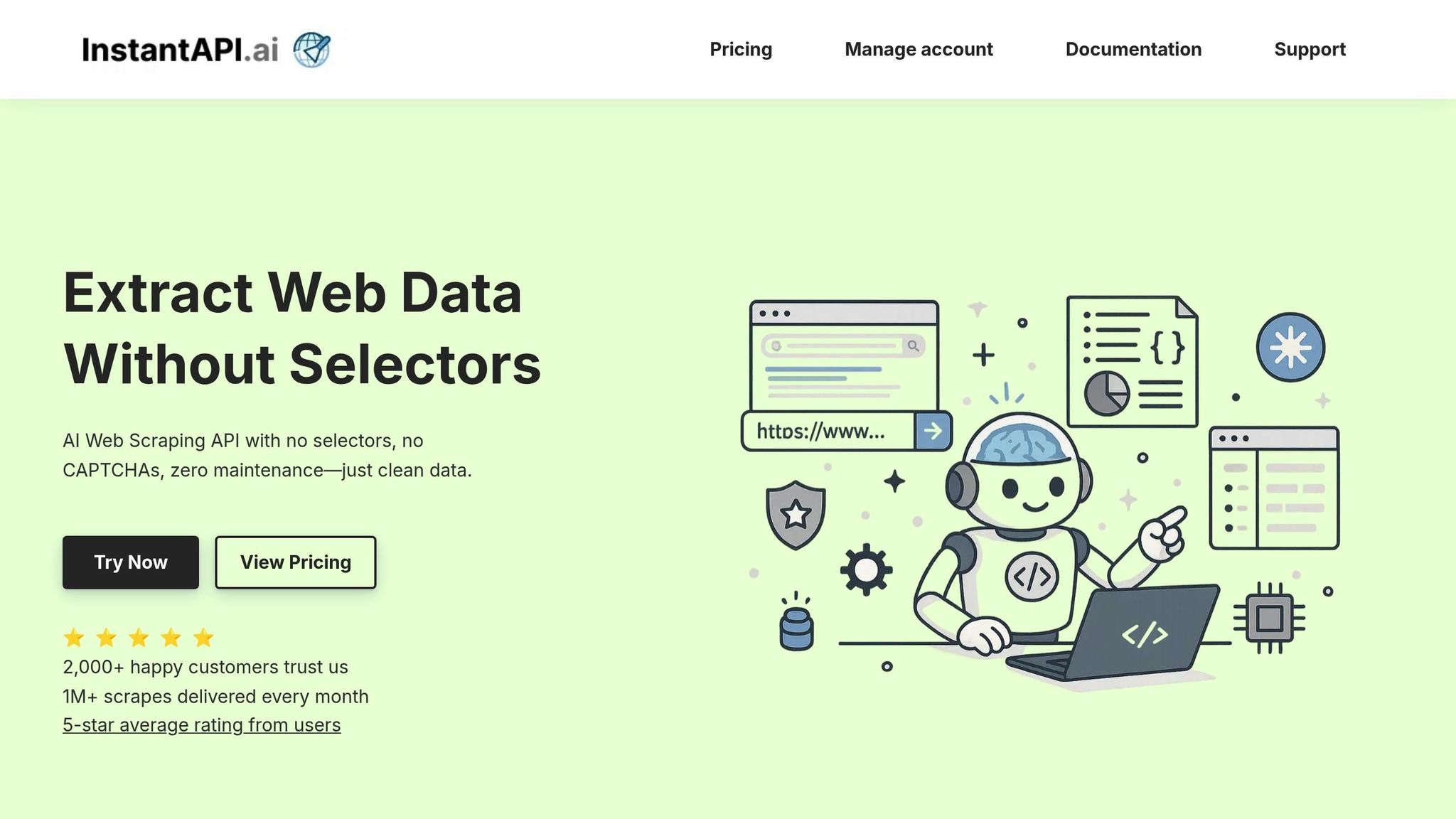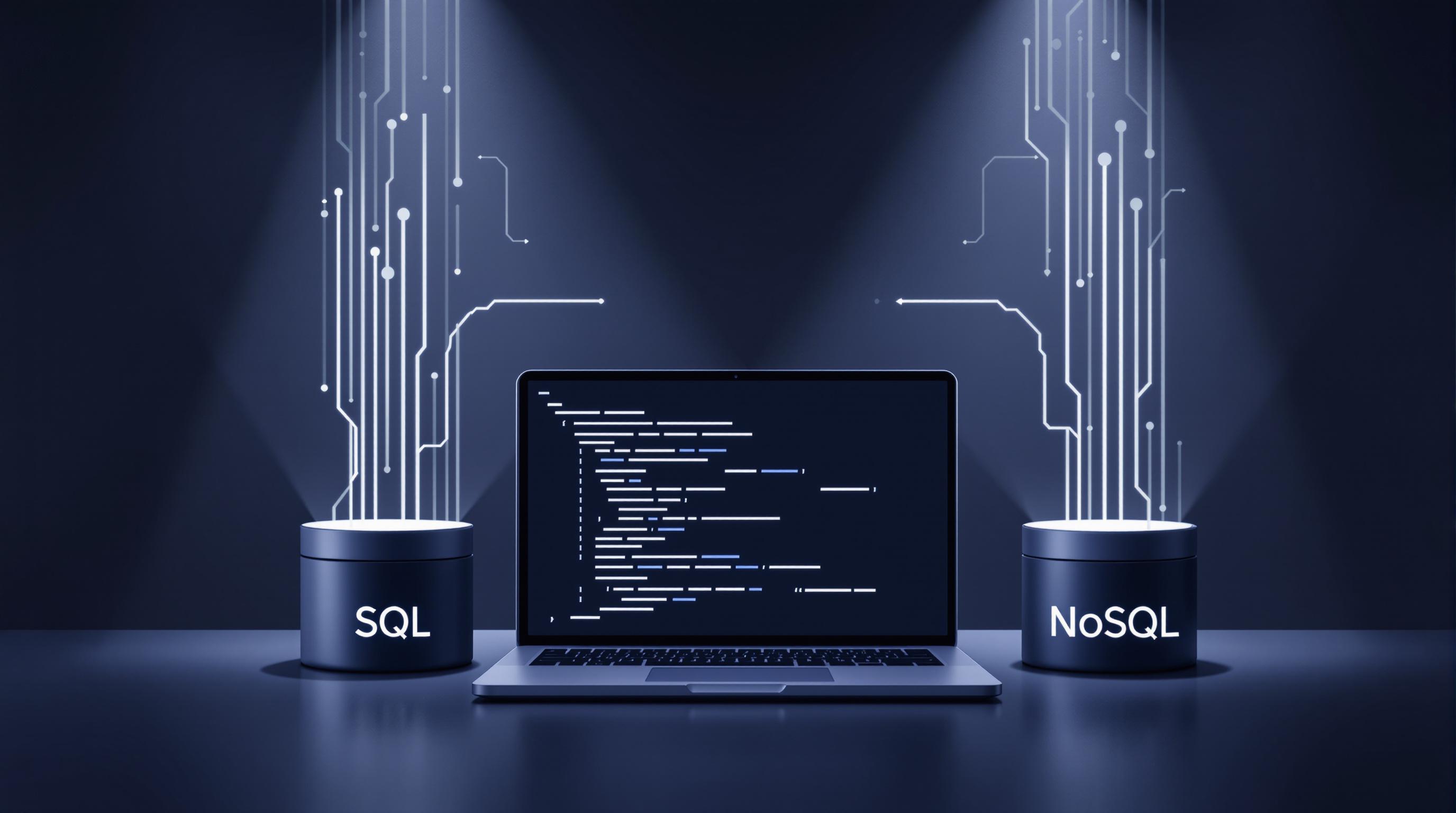Web scraping is transforming how toy companies track trends, analyze consumer preferences, and stay competitive. By automating data collection from platforms like Amazon, TikTok, and review sites, businesses can:
- Monitor competitor pricing and stock in real-time.
- Identify emerging trends, like "Kidults" buying toys for themselves.
- Analyze customer reviews to understand product satisfaction and pain points.
- Use social media insights to detect viral products and regional preferences.
For instance, tools like InstantAPI.ai simplify the process with automated scraping, dynamic content handling, and pay-per-use pricing, making it accessible even for non-technical users. Ethical practices, like respecting website policies and avoiding personal data collection, are vital for sustainable operations.
Web scraping equips toy companies with actionable insights to make smarter decisions, optimize inventory, and tailor marketing strategies effectively.
How to Scrape Data for Market Research (full project)
Main Online Data Sources for Toy Industry Trends
To effectively analyze trends in the toy industry, it's crucial to focus on platforms where consumers share their preferences and make purchases. By combining insights from various sources, businesses can gain a clearer understanding of market dynamics and shopper behavior.
E-Commerce Platforms
E-commerce platforms are treasure troves of data, capturing every detail about transactions. Sites like Amazon, eBay, Walmart, and Target provide a wealth of information - product details, reviews, pricing, and sales figures - that help track consumer preferences, competitive positioning, and emerging trends, such as the rise of personalized toys and subscription boxes.
Key insights include:
- Product Listings and Descriptions: These offer a foundation for analyzing trends. By scraping product details, businesses can spot popular features, seasonal patterns, and new categories.
- Customer Reviews and Ratings: Reviews go beyond what people buy - they reveal why they buy and how satisfied they are, offering direct insights into consumer preferences.
- Pricing Data: Tracking price fluctuations across platforms helps with competitive analysis and strategic pricing.
- Sales Figures and Inventory Levels: Monitoring stock levels, bestseller rankings, and sales velocity provides real-time intelligence on trending products.
One notable trend is the rise of "Kidults" - adults purchasing toys for themselves. This growing audience demands fresh marketing strategies and tailored product offerings to meet their unique preferences.
Social Media and Discussion Forums
While e-commerce data provides hard numbers, social media platforms capture the emotional and cultural pulse of consumers. Platforms like Facebook, Instagram, TikTok, Reddit, and YouTube reveal trends in real time, helping businesses identify viral products and regional preferences early on.
Here’s how social media contributes to trend analysis:
- Hashtag and Keyword Tracking: Parents, kids, and toy fans often use specific hashtags to discuss new products, share unboxing videos, and recommend favorites. These trends often emerge before hitting mainstream retail.
- Influencer Analysis: Influencers, especially micro (10K–100K followers) and nano (under 10K followers), drive meaningful engagement. Authentic posts from these influencers offer a 6x higher ROI compared to traditional ads.
- Sentiment Analysis: Analyzing consumer conversations helps brands understand how people feel about specific toys or brands. Personalized posts saw a 37% higher engagement rate in 2024 compared to generic ones.
- Geographic Sentiment Variations: Social media scraping reveals regional differences in preferences, enabling brands to tailor strategies for specific markets.
Online Reviews and Rating Sites
Online review platforms like Trustpilot, Google Reviews, and retailer-specific sections provide detailed insights into product performance and customer satisfaction. These reviews go beyond simple star ratings, offering a deeper look into consumer experiences.
Some key statistics highlight their importance:
- 99.5% of shoppers read reviews before making online purchases, and 84% trust reviews as much as personal recommendations.
- Parents often leave detailed feedback on aspects like toy durability, educational value, age suitability, and safety.
Other insights include:
- Response Analysis: Tracking how brands respond to reviews sheds light on their customer service and responsiveness. Notably, 79% of brands that acted on live sentiment data reported improved brand perception within 48 hours.
- Comparative Analysis: Reviewing feedback across multiple platforms helps businesses understand broader consumer sentiment. Seasonal trends also emerge, with online sales accounting for 38% of annual sales value during peak times like the holiday season.
How to Apply Web Scraping in the Toy Industry
Web scraping plays a game-changing role in the toy industry, especially when it comes to keeping up with competitors, spotting trends, and understanding customer sentiment. By turning raw data into actionable insights, businesses can make smarter decisions that directly impact market positioning and profits.
Competitive Analysis
Staying ahead in the toy market means keeping a close eye on competitors, and web scraping makes this easier than ever. By gathering real-time data, companies can track pricing strategies, new product launches, and market positioning to stay one step ahead.
- Price monitoring: Scraping pricing data from major retailers like Amazon, Walmart, and Target helps companies adjust their pricing strategies based on seasonal trends or competitor moves.
- Product launch detection: Automatic alerts on new toy lines or seasonal offerings allow businesses to tweak their marketing and production timelines.
- Market gap identification: By analyzing competitor inventories across platforms like Etsy, Toys "R" Us, and eBay, companies can uncover underserved categories or price points, revealing opportunities to meet consumer demand.
Additionally, companies can scrape data such as product names, prices, customer reviews, and ratings to develop dynamic pricing strategies. This data also helps identify seasonal patterns and shifts in consumer preferences, ensuring businesses can adapt quickly to changing market conditions.
Trend Spotting and Seasonal Patterns
Beyond competition, web scraping is a powerful tool for identifying market trends and understanding seasonal demand. This insight helps toy companies optimize inventory and marketing strategies.
- Seasonal demand forecasting: By combining data from multiple sources, businesses can predict when and where specific toys will be in demand. For example, stocking up on winter-themed toys ahead of the holiday season in colder regions.
- Emerging trend identification: Monitoring high-performing product categories and analyzing keywords in product descriptions can help businesses spot trends before they go mainstream. Social media scraping further enhances this by capturing user-generated content about trending toys.
- Geographic and seasonal preference mapping: Companies can use scraping to understand how toy preferences vary by region and time of year, which is invaluable for planning regional campaigns or promotions.
- Real-time market intelligence: If a toy suddenly gains popularity, web scraping can alert businesses to shift their focus immediately, ensuring they don’t miss out on a hot trend.
Consumer Sentiment Analysis
Sales numbers only tell part of the story. To truly understand what drives customer decisions, toy companies need to dig into consumer sentiment, and web scraping makes this possible.
- Review analysis: Extracting feedback from customer reviews sheds light on what buyers value most - whether it’s durability, safety, or educational benefits.
- Social media sentiment tracking: Monitoring platforms like Instagram or Twitter provides real-time insights into how consumers feel about new products or ad campaigns.
- Pain point identification: Negative feedback from e-commerce sites or social media can reveal common issues, helping companies address concerns and improve their offerings.
- Competitive sentiment comparison: By analyzing how consumers talk about different brands, businesses can gauge their reputation compared to competitors.
Visualizing this sentiment data through charts or heatmaps can highlight trends and help companies make informed decisions about product design, marketing, and customer service. With these insights, toy companies can better align their strategies with consumer expectations and stay ahead in the market.
Tools and Technology for Web Scraping
The tools you choose for web scraping can have a major impact on how effectively you gather data, especially in an industry like toys, where trends shift quickly. While there are plenty of options out there, each comes with its strengths and limitations that could influence your ability to stay on top of market trends.
Traditional Tools: Pros and Cons
BeautifulSoup continues to be a favorite among Python developers for parsing HTML and XML documents. It’s great for straightforward scraping tasks and has solid documentation to guide users. However, it struggles when dealing with JavaScript-heavy websites, which makes it less effective for scraping dynamic toy listings from platforms like Amazon or Target.
Scrapy is a powerful framework designed for large-scale scraping projects. It’s efficient at handling multiple requests, and it comes with built-in support for cookies and sessions. The downside? It has a steep learning curve and requires regular maintenance, which can eat up time and resources.
Selenium shines when it comes to scraping JavaScript-driven content. It can handle interactive elements like product galleries or infinite scrolling, which are common on modern toy retail sites. But it’s resource-heavy and slower compared to other tools. Running headless browsers at scale also demands significant infrastructure, which can become a bottleneck when monitoring multiple retailers.
Despite their capabilities, these traditional tools share common challenges, such as selector drift, proxy issues, and CAPTCHA roadblocks. These hurdles often make traditional methods less efficient for long-term use.
InstantAPI.ai: A Modern Alternative

InstantAPI.ai offers a streamlined solution by removing the technical hurdles. Instead of manually setting up CSS selectors or juggling proxy pools, you simply define the data you need in a JSON format, and the AI handles the rest. Unlike traditional tools, it adapts automatically to changes in website structures, ensuring uninterrupted data collection - even when retailers update their pages.
Its automated proxy management provides access to over 65 million rotating IPs across 195 countries, while built-in rendering takes care of dynamic content without relying on headless browsers. Pricing is straightforward, too, with a pay-per-use model at $2 per 1,000 pages, making it easy to scale during peak seasons without overspending.
"After trying several other solutions, we were won over by the simplicity of InstantAPI.ai's AI Web Scraping API. It's fast, straightforward, and lets us focus on what matters most - our core features." - Juan, Scalista GmbH
With over 2,000 customers and more than 1 million monthly scrapes, InstantAPI.ai boasts a success rate of 99.99% or higher. It also caters to both technical and non-technical users, offering a Chrome extension for quick, no-code scraping and a robust API for developers.
Comparison Table: Traditional Tools vs. InstantAPI.ai
| Feature | Traditional Tools | InstantAPI.ai |
|---|---|---|
| Setup Complexity | High – requires coding, proxy setup, browser management | Low – simple API call with JSON schema |
| Maintenance | Constant – selectors break, proxies fail, browsers crash | Zero – automatically adapts to site changes |
| JavaScript Support | Manual – requires Selenium or similar tools | Automatic – built-in rendering |
| Proxy Management | Manual – source and rotate proxies yourself | Automatic – 65+ million IPs across 195 countries |
| CAPTCHA Handling | Manual – integrate third-party services | Automatic – built-in bypass |
| Pricing Model | Fixed monthly costs or complex tiers | Pay-per-use: $2 per 1,000 pages |
| Scalability | Limited by infrastructure and maintenance | Unlimited – scales automatically |
| Success Rate | Variable – depends on your implementation | 99.99%+ guaranteed |
The pay-per-use model ensures you only spend on what you actually need. This approach is especially helpful for toy companies, as it allows them to scale up during busy seasons and cut back during quieter periods. InstantAPI.ai offers an efficient, hassle-free way to track trends and consumer preferences without the headaches that come with traditional web scraping methods.
sbb-itb-f2fbbd7
Best Practices and Ethics for Web Scraping
Once you've chosen the right tools for web scraping, it's crucial to follow best practices to ensure your efforts are both effective and respectful. In the toy industry, where data often involves sensitive information - and occasionally concerns children - maintaining ethical standards is especially important. Striking a balance between your data needs and respect for website owners, consumers, and legal frameworks is key.
Following Website Policies
Before diving into scraping, always check the website's robots.txt file (e.g., amazon.com/robots.txt). These files outline areas that are off-limits for automated tools. For example, major retailers like Target and Walmart use these files to safeguard sensitive sections, such as checkout pages or user accounts.
Take the time to review the site's Terms of Service (ToS). Many e-commerce platforms explicitly forbid automated data collection, including scraping product prices. Ignoring these terms could lead to legal consequences or permanent IP bans.
In the United States, scraping publicly available data is generally allowed by courts, but this doesn't override specific website policies or copyright laws. For instance, toy reviews or product descriptions might be protected by copyright, requiring proper attribution if used.
Transparency is also essential. Always include a clear user agent string in your requests that identifies your company and contact information. This small step helps website administrators understand the purpose of your activity and builds trust.
Reducing Server Load and Data Usage
To avoid overloading servers, space your requests 1–2 seconds apart. Be especially mindful during peak traffic periods like Black Friday or the holiday season when websites are already under heavy strain.
Instead of scraping every individual product page, focus on more efficient methods. For instance, gathering data from category pages or search results can provide insights without overwhelming the target site. If you're monitoring toy trends, you might only need data on the top 100 bestselling items rather than an entire catalog.
Limit your data collection to what's necessary. For example, when tracking toy prices, avoid collecting unrelated information. This approach not only reduces server strain but also keeps your storage and bandwidth costs in check.
Implement retry logic with exponential backoff for failed requests. This means waiting progressively longer between retries instead of bombarding the server. This method is particularly useful during temporary outages or high-traffic times, helping maintain a respectful relationship with the target website.
Handling Consumer Data Responsibly
Privacy is a major concern in the toy industry, especially when dealing with consumer data. Avoid collecting personally identifiable information (PII) like usernames, email addresses, phone numbers, or detailed location data from reviews or social media posts.
A study shows that 66.8% of U.S. adults oppose the use of their personal data for targeted advertising. With this in mind, focus on aggregated trends and sentiment analysis rather than individual user behavior. For example, instead of storing individual reviews, you could analyze overall trends, such as a 15% increase in positive mentions of "STEM toys" this quarter compared to the last.
When working with user-generated content like toy reviews, always include proper attribution by linking back to the original source. This respects the rights of content creators and ensures transparency. If you intend to use scraped content commercially, make sure you're compliant with copyright laws and obtain any required permissions.
"Scrape only what is necessary - ethical practices demand both precision and restraint." - Vinod Chugani, Data Science Professional
Monitor the impact of your scraping activities on site performance. If your requests are slowing down the target site, reduce your frequency or add longer delays. Regularly adjust your strategy as legal and ethical standards evolve, particularly around privacy and consumer rights.
Conclusion: Web Scraping Benefits for the Toy Industry
Web scraping has proven to be a game-changer for professionals in the toy industry, reshaping how businesses gather market insights and make informed decisions.
"Web scraping is more than just a technical tool - it's a strategic asset that empowers businesses to make informed decisions, identify trends and maintain a competitive edge." - Jacob (Yakup) Kalvo, CEO of Live Proxies
Key Advantages of Web Scraping for the Toy Market
Web scraping offers a range of benefits that help toy companies stay ahead in a competitive market:
- Competitive Analysis and Trend Monitoring: By tracking competitors and staying updated on market trends, businesses can better understand customer preferences and adapt quickly.
- Improved Inventory Management: Real-time data on product availability and demand helps prevent stockouts during busy seasons like the holidays and reduces overstock during slower periods.
- Dynamic Pricing: Monitoring prices across retailers enables companies to adjust their pricing strategies to stay competitive without compromising profits.
- Targeted Marketing: Insights from customer conversations allow for more effective marketing campaigns tailored to what customers are talking about and looking for.
- Cost Efficiency: Web scraping provides a budget-friendly alternative to hiring data entry teams or purchasing expensive market research reports, making it accessible even for smaller businesses.
These advantages equip toy industry professionals with the tools they need to make data-driven decisions and respond nimbly to market changes.
How to Get Started with Web Scraping
To capitalize on these benefits, toy companies need to take practical steps toward implementing web scraping. The first step is choosing the right solution. Modern tools have simplified the process, making it accessible even to those without technical expertise.
For instance, InstantAPI.ai offers a straightforward pay-per-use model at $2 per 1,000 web pages scraped. This includes features like unlimited pages, concurrency, and live support - all without requiring complex setup. Users simply point the API at a public URL and receive clean, structured JSON data.
"After trying several other solutions, we were won over by the simplicity of InstantAPI.ai's AI Web Scraping API. It's fast, straightforward, and lets us focus on what matters most - our core features." - Juan, Scalista GmbH
To get started, businesses should define clear data objectives. Whether the goal is tracking competitor pricing, identifying trending toys, or analyzing customer sentiment, knowing what to collect and how often is crucial for success.
Finally, ethical practices are essential. By respecting website policies, including implementing delays between requests and focusing on publicly available data, companies can ensure their operations remain sustainable and responsible while protecting their reputations.
FAQs
What are the best practices for ethical web scraping in the toy industry?
To practice ethical web scraping, toy companies should keep these guidelines in mind:
- Follow website terms of service: Stick to the rules outlined by websites to ensure data collection is authorized and above board.
- Steer clear of personal data: Avoid gathering personally identifiable information (PII) unless you have clear and explicit consent from users.
- Leverage public APIs: When available, APIs provide a structured and ethical way to access data, as they are designed for sharing information.
- Adhere to data privacy laws: Stay compliant with regulations like GDPR and CCPA to safeguard user privacy and avoid potential legal issues.
By staying transparent and respecting these principles, companies can collect valuable insights responsibly while maintaining user trust and meeting legal obligations.
What are the key benefits of using InstantAPI.ai for tracking toy industry trends and consumer preferences?
How InstantAPI.ai Helps Track Toy Industry Trends
Keeping up with toy industry trends can be a challenge, but InstantAPI.ai makes it easier by automating data collection from various sources like e-commerce sites, social media, and online reviews. This means you get timely insights without the hassle of manual research.
The platform’s tools are designed to be both scalable and efficient, helping you spot emerging trends, identify popular toys, and understand shifting consumer preferences quickly. This empowers industry professionals to make smart, timely decisions that keep them ahead in a competitive market. Plus, by simplifying the process, InstantAPI.ai cuts down on the time, cost, and complexity that often come with traditional web scraping methods - perfect for the fast-moving world of toys.
How can web scraping help toy companies understand and adapt to the growing 'Kidults' trend?
Web scraping offers toy companies a way to tap into the growing 'Kidults' trend by gathering insights from online platforms like e-commerce sites, social media, and customer reviews. This method helps uncover details about popular products, shifting preferences, and buying habits among adults who are drawn to collectibles and nostalgic toys.
Using web scraping, businesses can keep an eye on competitor pricing, spot trending toys, and gauge consumer sentiment in real time. With this information, companies can refine their strategies, craft targeted marketing campaigns, and design products that resonate with this expanding demographic - a group that now holds a notable share of the toy market. Relying on data-driven insights helps businesses stay competitive and make the most of the opportunities presented by the 'Kidults' phenomenon.


